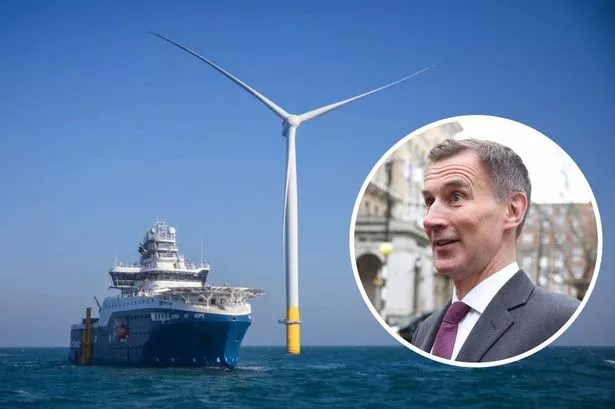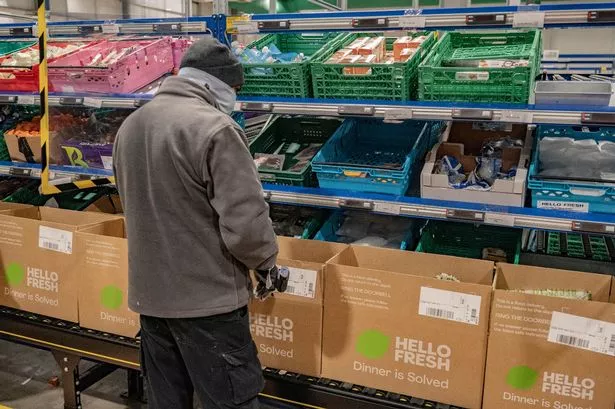
Developer pulls application for £750m Leicestershire rail freight hub – but says it’s just a temporary thing
The developer behind a controversial £750m rail freight hub in the west Leicestershire countryside says it has temporarily pulled its planning application in order to add new information. Tritax Symmetry wants to build the 440 acre Hinckley National Rail Freight Interchange between Hinckley and the village of Elmesthorpe. The vast scheme, just off the M69 and along the Leicester to Birmingham railway line, has drawn criticism from local councils, MPs and residents who say the public consultation has not been up to scratch. Tritax Symmetry said it will create thousands of jobs, bring investment to the area and take polluting trucks off the roads. A planning inspector was due to decide this month if the rail hub and warehousing should go through to the next round of consultations prior to a six-month examination phase – including hearings – later this year. A decision was expected by the middle of next year. Now Tritax Symmetry says it has temporarily withdrawn the application following discussions with the Planning Inspectorate in order to submit an additional “minor” piece of information at the inspectorate’s request. It said it relates to a greenhouse gas emissions and carbon assessment for the construction of offsite highway works. The commercial property developer said the updated application will probably be resubmitted this month. Nick Payne, development director at Tritax Symmetry said: “Working collaboratively with the Planning Inspectorate, we have temporarily withdrawn the application in order to submit an additional minor piece of information at their request, on a Greenhouse Gas Emissions and Embodied Carbon Assessment for construction of the offsite highway works. "Unfortunately, the strict Development Consent Order process does not allow us to submit further information at this stage, so we have to withdraw and then resubmit.”

Orsted committed to 'green-lighting' £8b Hornsea Three offshore wind farm despite Budget disappointment
Offshore wind giant Orsted remains committed to delivering its next huge wind farm off the Humber, despite expressing disappointment at a lack of support in the Budget. Soaring prices fuelled by energy costs and other inflationary measures brought about by the invasion of Ukraine have put huge pressure on the ability to deliver at the record low price Hornsea Three was secured at, having been proposed before the Russian offensive. Ahead of the Budget, the Danish giant’s UK head, Duncan Clark, warned the 2.8GW farm could even be put on hold. An increase in capital allowances lasting three years has been described by the industry as a measure not bold enough. Much of the Net Zero pump-priming was focused on industrial emission abatement through carbon capture and new nuclear. Read more: Urgent next steps detail sought by businesses behind carbon capture plans Hornsea Three, double the size of the leading wind farm in a cluster supported by 540 employees in Grimsby, was awarded a new low subsidy price of £37.35 last summer. Mr Clark said: “It is disappointing that the Government has not put in place a full package of support for the renewables industry in the Spring Budget. Under the Government’s proposals, we understand long-life infrastructure projects such as offshore wind farms would only qualify for a 50 per cent capital allowance for three years. Furthermore, the lion’s share of capital expenditure on Hornsea Three and other forthcoming offshore wind projects will come outside the qualifying scope and timeframe. “We will now need to take some time to analyse the anticipated impact of these proposals on our future projects. We remain committed to doing all we can to reach final investment decision on Hornsea Three, a project Orsted has been developing for more than a decade. Our project team, together with our supply chain partners, will continue to seek creative solutions that we hope will allow us to green-light Hornsea Three in the future, realising an £8 billion investment in the UK with thousands of jobs during construction and billions invested in the UK supply chain.” The company has already invested almost £10 billion in the Humber region alone, and a decision had been thought to be imminent. Only last month the company announced record earnings of £3.8 billion, with a third of that figure generated from the sale of significant stakes in completed farms, including Hornsea Two. “In the next decade, it is the rapid build-out of renewable energy that will enable us to become independent of gas and other fossil fuels and to ensure security of supply for the UK,” Mr Clark added. “The offshore wind sector has delivered huge growth in the UK over the last decade but it has arrived at an inflection point. It will require continued focus from stakeholders in government and across industry to ensure offshore wind delivers on its potential to become the backbone of the UK’s energy system and bring billions of pounds of investment, provide low-cost electricity for consumers and help deliver our net zero target.” Trade body RenewableUK welcomed investment zones to help expand supply chains, a key element in the imminent Humber Freeport, but said it didn’t match the ”comprehensive industrial strategy” required. Stating the framework needed to mobilise investment to make the UK a clean energy superpower hadn’t been delivered this week, executive director of policy and engagement Ana Musat said: “Overall we need a much bigger response to match the incentives being offered to renewable energy developers by the US and the EU – this wasn’t forthcoming, and we hope the Chancellor’s announcements later this month on the UK’s pathway to net zero and energy security will remove the key fiscal and non-fiscal barriers to the growth of the renewables sector”.

Post-Covid bookings take off again at easyJet
Budget airline easyJet says losses will be better than expected after seeing a big increase in bookings. The Luton-based operator – which flies out of UK airports such as Birmingham, Stansted, Manchester and Newcastle – said it had seen a record surge in bookings since the start of the year. Headline pre-tax losses, it said, narrowed to £133 million in the last three months of 2022, compared to £213 million a year earlier. It also carried almost 50 per cent more passengers in the same period – at 17.5 million – compared to the end of 2021 when the country was still dealing with Covid-19. UK coronavirus travel restrictions were finally dropped last March. To cap that off it has had a good bounce-back in traditional New Year holiday bookings, with three weekends of record-breaking sales so far in January. The group said it now expects its seasonal first-half loss to be “significantly” better year on year. Chief executive Johan Lundgren said: “We have seen strong and sustained demand for travel over the first quarter, carrying almost 50 per cent more customers compared with last year. “Many returned to make bookings during the traditional turn-of-year sale where we filled five aircraft every minute in the peak hours, which culminated in three record‐breaking weekends for sales revenue this month. “This strong booking performance, aided by the airline’s step-changed revenue capability, has driven an £80 million year-on-year boost in the first quarter with continued momentum as customers prioritise spending on holidays for the year ahead. “This will set us firmly on the path to delivering a full-year profit, where we anticipate beating the current market expectation, enabling us to create value for customers, investors and the economies we serve.” EasyJet said the most popular destinations for UK travellers this year were Amsterdam, Geneva, Paris, Tenerife and Alicante. Mr Lundgren said: “Coming into the summer, the early indication is it’s really down to the places that offer great value for money (such as) Turkey and Egypt. But also Spain is popular. “It’s very clear that people are really prioritising taking a beach holiday for this summer.” EasyJet was one of the airlines worst affected by staffing shortages which hit the aviation industry last year, though the CEO said staffing numbers were now “well ahead” of pre-coronavirus levels.

Aggregates giant Breedon planning move from AIM to main stock market as sales hit £1.4bn
Management at Breedon Group have said they plan to move it from the AIM stock exchange to the Main Market to better reflect its “scale and heritage”. The announcement comes as new figures show the Leicestershire-based construction materials giant hit revenues of £1.4 billion last year, up 13 per cent on 2021. Pre-tax profits were up a fifth at £136 million. Cement sales in particular had a record year, up 22 per cent with margins also up, helped by resilient markets and prices getting stronger. Shares in the business were up around 4 per cent today at 77.6p. Despite the UK economy looking uncertain – particularly when it comes to housebuilding – the business said UK Infrastructure and industrial construction were expected to grow in 2023, underpinned by big ongoing projects. The company’s directors said moving Breedon's ordinary shares to the premium listing segment of the Official List and to trading on the Main Market of the London Stock Exchange would further enhance its corporate profile and recognition. It would also allow index tracker funds and a broader group of international institutional investors to put money into the group. However, management said there are no plans to raise funds in connection with the admission. The business has grown exponentially since its 2010 launch. Back then it owned around 180 million tonnes of mineral reserves and resources and operated 29 quarries in Great Britain. Today it has a billion tonnes of mineral reserves and resources and operate more than 300 sites across the UK and Ireland. It employs around 3,700 people. Non-executive chairman Amit Bhatia said: “Being a member of AIM has served us well. For over a decade the AIM market provided us with access to diverse and engaged investors, within a supportive community that understands the needs of entrepreneurial businesses such as Breedon and we thank them wholeheartedly for their support. “As an established business, with a track record for growth and value creation, we believe the Main Market now offers the appropriate listing for a company of our scale and heritage and, subject to the required approvals, look forward to our future as a member of the Official List.” As part of admission, the directors intend to establish a new holding company called New Breedon and undertake a share consolidation to reduce the absolute number of shares in issue. A general meeting will be called to approve the plans in due course. Russ Mould, investment director at online stockbroker AJ Bell, gives his thoughts on moving from the AIM to the Main Market “Breedon has announced plans to move from AIM to London’s Main Market. There was a time when that was all the rage, with companies eager to step up and have the badge of honour of being a Main Market-listed business. “There was also the argument that many fund managers weren’t allowed to invest in AIM stocks and so by moving up to the Main Market they could get on the radar of more institutional investors. "That doesn’t really apply these days as most fund managers don’t have those restrictions. “Instead, a key reason to switch is to benefit from tracker funds buying the shares. Breedon is valued at £1.3 billion which would put it in the middle of the FTSE 250 index by size. "Once the company qualifies for the index, tracker funds mirroring the performance of the FTSE 250 would need to own the shares so they become active buyers. “Reputation is the other main reason for switching markets these days as a company can say it adheres to the stricter rules that come with the Main Market. “AIM was originally pitched as a stepping-stone for smaller companies, a place for them to tap capital markets and grow. "Moving market once they’ve seen significant growth makes perfect sense and in Breedon’s case it has greatly expanded sales and assets since joining AIM. “ASOS made the switch last year and going back a while, Domino’s Pizza and Petra Diamonds are other examples of companies to move from AIM to the Main Market.” Chief executive Rob Wood said: “2022 was another record year. Each division progressed and we made meaningful headway on our growth strategy, expanding organically, acquiring strategically important assets, and moving our sustainability agenda forward. “We grew sustainably through replenishing and optimising our mineral assets, investing in our colleague's safety and wellbeing, and reducing our carbon footprint while maintaining a secure financial position. We have a mineral pipeline in excess of 100 million tonnes, we achieved the highest substitution of fossil fuels at our cement plants in our history, and we invested for growth while still reducing our leverage. “In recent years our local and entrepreneurial operating model has been tried and tested, keeping our people safe while growing high-quality earnings, and maintaining a strong balance sheet.

HelloFresh starts work on 400,000 sq ft distribution centre on SmartParc food campus in Derby
Home meal kit maker HelloFresh has started work on a 400,000 sq ft distribution centre on the SmartParc food manufacturing campus in Derby. The building – due to open in spring 2024 and called The Windmill – is being built near to an existing HelloFresh packing and distribution hub called The Orchard, which opened last year. A spokeswoman would not said how many jobs will be created, but smaller Orchard site is believed to have around 450 people working there. She said the will be a recruitment drive “in due course”. When finished The Windmill will be the company’s most advanced distribution centre in terms of its technology and sustainability credentials – sharing its heating and cooling arrangements with other tenants on the business park in addition to making high use of wind, solar and green energy. German-based HelloFresh this week reported global sales up 27 per cent at 7.6 billion euros in 2022 (£6.77 billion), after shipping more than a billion meals through the year to 7 million active customers. But it said adjusted core profit was down 9.5 per cent at 477.4 million euros (£425.5 million) as it worked to get to grips with record levels of inflation in ingredients and labour costs. HelloFresh UK chief executive Adam Park said: “The new site will allow us to use state-of-the-art technology to innovate and continuously improve our product offering. “That way we will be able to offer our customers more choice, flexibility and overall better service levels, all while seamlessly fitting into their everyday lives. “In addition, the new site will focus on maximising energy efficiency and minimising environmental impact. By investing into the new site, HelloFresh is reinforcing its commitment to Derby. “It’s also fantastic to continue our association with SmartParc. The campus sets a precedent for the best in sustainable design and collaboration. “Their ethos of bringing people and businesses together to meet the challenges of sustainable food production, while providing opportunities for the local area, align perfectly with our own values.” SmartParc chief executive Jackie Wild said: "We are delighted to be working with HelloFresh on their new Windmill production facility at SmartParc SEGRO Derby. “As our anchor tenants, HelloFresh are an important part of our journey to deliver for the city of Derby and enable sustainable, collaborative food production."

Innes England: Tough East Mids commercial property market could bounce-back after shock of ‘Trussonomics’
Management at one of the region’s leading commercial property agencies are hopeful the market will start to improve this year following the economic meltdown caused by the short-lived Liz Truss Government. According to the 16 th annual Innes England Market Insite report, 2023 could see the green shoots of recovery after total regional investment in commercial real estate dropped 44 per cent last year to around £1.36 billion. In a virtual presentation to industry professionals, Ben Robinson, head of the company’s investment consultancy, said: “As we begin 2023 we are cautiously optimistic that despite the re-rating of commercial property yields at the end of last year, transaction activity will return as investors quickly become acclimatised to the new norm.” Transactions across the region in the first half of 2022 had continued at much the same level as the previous year, when volumes ended at record highs. He said: “However, this strong investor momentum started to fade in the second half of the year as the market began to absorb the effects of the first significant rises in interest rates since the financial crisis, before falling away sharply following the further shock of ‘Trussonomics’.” “As the era of cheap money came to a rather abrupt end towards the latter part of the year many investors adopted a wait-and-see approach whilst commercial property yields re-rated across all sectors.” That was reflected in the drop in transaction volumes in the second half, with only £239 million worth of deals across the whole East Midlands market. He added: “However, we expect the market to recover following a quiet start to the year as investors look to take the opportunities of a thinner market while it lasts.” Innes England director Peter Doleman said a record start to the year for warehousing and distribution properties gave way to a decline in the second half – but it was not at crisis levels. Leicestershire saw a 39 per cent rise in logistics deals last year thanks to its central England location, with notable sites including Magna Park and the Leicester Distribution Park. • The industrial and beds sector again dominated, accounting for 80 per cent of all investment transactions • Nottingham bucked the regional trend with total investment at nearly £500 million) - up 68 per cent on the previous year’s £306 million - thanks mainly to purpose-built student accommodation deals • Leicester saw ‘strong’ levels of industrial take-up at 4 million sq ft, almost 39 per cent higher than last year • Investor demand for city centre offices in Nottingham continued, with notable deals featuring Corum IM’s purchase of EON’s Trinity House for £28 million • The East Midlands had the third lowest net decline in shop closures - and saw retail space take-ups dominated by food and beverage operators • Total investment in Derbyshire in 2022 was just over £300 million, slightly down (23 per cent) on the previous year but still 26 per cent up on the five-year rolling average • Industrial investment dominated in Derby - more than a third up at £243 million. Deals included ICG’s £101 million purchase of two logistic units at Mercia Park, Swadlincote Fellow director Craig Straw, head of Innes England’s business space agency team, said office take-up transactions were down across the region by about 25 per cent but that followed a bumper post-pandemic 2021. Nottingham’s office take-up was the most robust with a strong focus on the city centre. Activity in Leicester and Derby was high on the edge of city and out of town, but big transactions were thin on the ground. Innes England managing director Matt Hannah said shop landlords and tenants had had to make big changes in a year which saw 17,000 UK shop closures. He said: “A third of all closures came from a reduction in branch networks by the nationals and a further third, unfortunately, from the independent sector. “The East Midlands had the third lowest net decline in these numbers which reflect a 50 per cent increase across the country over 2021. The reduction of government support and removal of the rent moratorium played significant roles.” The most significant boost to city centres is the long-anticipated rating reassessment this April which will see an immediate reduction of retailers’ occupancy costs. Mr Hannah said: “Some units we are marketing are showing a 65 per cent drop in the rates payable or, for example, a reduction on one unit from £70,000 a year to £25,000.” This year’s Market Insite report includes Birmingham data, reflecting Innes England’s expansion to the city in 2022.